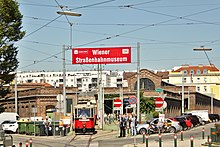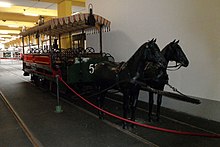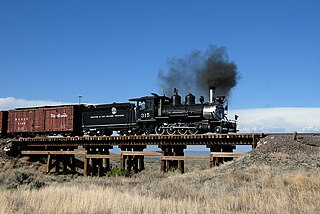
Conservation and restoration of rail vehicles aims to preserve historic rail vehicles. It may concern trains that have been removed from service and later restored to their past condition, or have never been removed from service, like UP 844, the only U.S. steam locomotive to never be retired. They are often operated in present-day service as moving examples of living history, as opposed to static exhibits.

Heritage streetcars or heritage trams are a part of the efforts to preserve rail transit heritage. In addition to preserving street-running rail vehicles, heritage streetcar operations can include upkeep of historic rail infrastructure. Working heritage streetcars are closely related to the growing global heritage railway movement and form a part of the living history of rail transport.
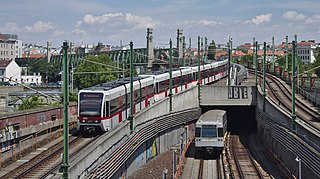
The Vienna U-Bahn, where U-Bahn is an abbreviation of the German word Untergrundbahn, is a rapid transit system serving Vienna, Austria. The five-line network consists of 83.1 kilometers (51.6 mi) of route, serving 109 stations. 459.8 million passengers rode the U-Bahn in 2019.
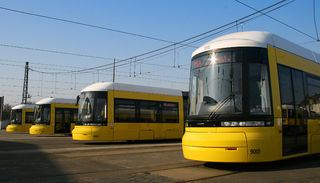
The Berlin tramway is the main tram system in Berlin, Germany. It is one of the oldest tram networks in the world having its origins in 1865 and is operated by Berliner Verkehrsbetriebe (BVG), which was founded in 1929. It is notable for being the third-largest tram system in the world, after Melbourne and St. Petersburg. Berlin's tram system is made up of 22 lines that operate across a standard gauge network, with almost 800 stops and measuring almost 190 kilometres (120 mi) in route length and 430 kilometres (270 mi) in line length. Nine of the lines, called Metrotram, operate 24 hours a day and are identified with the letter "M" before their number; the other thirteen lines are regular city tram lines and are identified by just a line number.

Wiener Linien is the company running most of the public transit network in the city of Vienna, Austria. It is part of the city corporation Wiener Stadtwerke.

The Sydney tramway network served the inner suburbs of Sydney, Australia, from 1879 until 1961. In its heyday, it was the largest in Australia, the second largest in the Commonwealth of Nations, and one of the largest in the world. The network was heavily worked, with about 1,600 cars in service at any one time at its peak during the 1930s . Patronage peaked in 1945 at 405 million passenger journeys. Its maximum street trackage totalled 291 km in 1923.

Vienna has an extensive transport system that includes roads, railways, trams, metro, and buses.

The Reichsbrücke is a major bridge in Vienna, linking Mexikoplatz in Leopoldstadt with the Donauinsel in Donaustadt across the Danube. The bridge is used by 50,000 vehicles per day and carries six lanes of traffic, U-Bahn tracks, two footpaths, two cyclepaths and two utility tunnels.

The Prague tramway network is the largest tram network in the Czech Republic, consisting of 144 km (89 mi) of standard gauge (1,435 mm) track, 882 tram vehicles and 26 daytime routes, 2 historical and 10 night routes with a total route length of 518 km (322 mi). It is operated by Dopravní podnik hlavního města Prahy a.s., a company owned by the city of Prague. The network is a part of Prague Integrated Transport, the city's integrated public transport system.
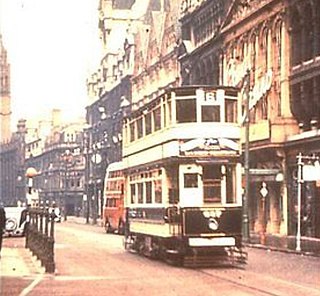
Birmingham Corporation Tramways operated a network of tramways in Birmingham from 1904 until 1953. It was the largest narrow-gauge tramway network in the UK, and was built to a gauge of 3 ft 6 in. It was the fourth largest tramway network in the UK behind London, Glasgow and Manchester.

The Dresden Transport Museum displays vehicles of all modes of transport, such as railway, shipping, road and air traffic, under one roof.

Dresdner Verkehrsbetriebe AG (DVB) is the municipal transport company of the city of Dresden in Germany. It is a member of the Verkehrsverbund Oberelbe transport association that manages a common public transport structure for Dresden and its surrounding areas. The DVB operates the Dresden tram network comprising 12 tram lines, with a total line length of approximately 210 kilometres (130.5 mi) and a total route length of 132.7 kilometres (82.5 mi), and 28 bus lines, with a total line length of approximately 306 kilometres (190.1 mi). It is also responsible for two funicular railways and three ferries across the River Elbe.

Trams in France date from 1837 when a 15 km steam tram line connected Montrond-les-Bains and Montbrison in the Loire. With the development of electric trams at the end of the 19th century, networks proliferated in French cities over a period of 15 years. Although nearly all of the country's tram systems were replaced by bus services in the 1930s or shortly after the Second World War, France is now in the forefront of the revival of tramways and light rail systems around the globe. Only tram lines in Lille and Saint-Étienne have operated continuously since the 19th century; the Marseille tramway system ran continuously until 2004 and only closed then for 3 years for extensive refurbishment into a modern tram network. Since the opening of the Nantes tramway in 1985, more than twenty towns and cities across France have built new tram lines. As of 2024, there are 28 operational tram networks in France, with 3 more planned. France is also home to Alstom, a leading tram manufacturer.

Trams in Vienna are a vital part of the public transport system in Vienna, capital city of Austria. In operation since 1865, with the completion of a 2 km (1.2 mi) route to industrial estates near Simmering, it reached its maximum extent of 292 km (181.4 mi) in 1942. In February 2015, it was the fifth largest tram network in the world, at about 176.9 kilometres (109.9 mi) in total length and 1,071 stations.

The Graz tramway network is a network of tramways forming an important part of the public transport system in Graz, which is both the capital city of the federal state of Styria, Austria, and the second largest city in Austria.

The Spårvägsmuseet, or Tramway Museum, was located at Tegelviksgatan 22 in Södermalm, Stockholm, Sweden. It was owned and operated by Storstockholms Lokaltrafik, and shows the development of public transportation in the Stockholm area from the 1650s until today. The Museum's mission also covers contemporary and future public transport in the Stockholm region, and water transportation in the area. The museum also houses a library, an archive and a café.
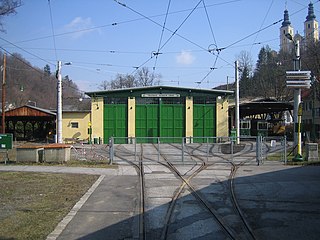
The Tramway Museum Graz is a transport museum in the Austrian city of Graz, specialising in the history of the Graz tramway network. It is located in the former tram depot at the Mariatrost terminus of Graz tram route 1.

The Brussels Urban Transport Museum, also known as the Tram Museum, is a transport museum in Woluwe-Saint-Pierre, a municipality of Brussels, Belgium.
The Vienna pre-metro tramway system was built on separated sections in the 1960s. The underground sections are called Untergrundstrassenbahn or sometimes abbreviated U-Strassenbahn, USTRAB or USTRABA . The pre-metro tunnels are maintained and used by the Wiener Linien, operator of the tramway lines. One section is used as well by the Wiener Lokalbahnen (WLB), the operator of a regional tram-train service.


